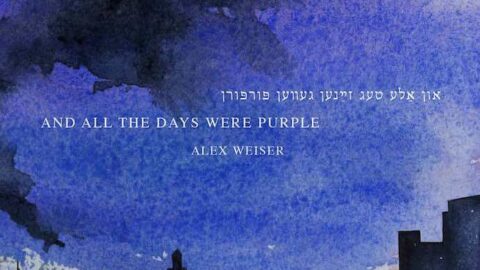Alex Weiser’s newest release and all the days were purple (Cantaloupe Music) is a gently haunting exploration of the search for the divine. Scored for string trio, piano, percussion, and soprano, the album includes two compositions: and all the days were purple, an eight-movement work featuring poems in both English and Yiddish by Anna Margolin, Edward Hirsch, Rachel Korn, and Abraham Sutzkever, and Three Epitaphs, a 14-minute composition including text by William Carlos Williams, Seikilos, and Emily Dickinson.
Weiser grew up with a limited connection to his Yiddish speaking grandparents, but has since found a deeper association with Judaism, both religiously and culturally. In the press release, Weiser says, “Even not believing that God exists, or that a religious text has some sacred truth to it–even without that, there’s still the pursuit of God. In a way these poems and songs are meant almost as replacements for prayers. They’re ways of searching for a divine order, of seeking enlightenment, of approaching transcendence.”
“My Joy,” the first movement of and all the days were purple, begins with softly voiced piano chords that are quickly joined by soprano Eliza Bagg and sustained string trio chords. Bagg approaches each new line with a particularly smooth onset, which gives the impression that the melodies have appeared out of nowhere. In music that focuses on the reverberation of long chords and swells–as opposed to melodic contrast and variation–a singer is given the added job of leading the ensemble both musically and emotionally. Bagg succeeds with every line. She makes her presence known without overpowering the rest of the musicians, who in turn blend their various rises and falls expertly with her delivery.

“My Joy” gives way to an instrumental track titled “*”. Featuring some of the album’s most dissonant moments and (relatively) bombastic events, “*” is based on long crescendos and trills, the timing of which are always in flux, ultimately giving the sense that an unchanging tempo is a secondary consideration. These crescendos flow without stop into a dramatic piano roll to open “I Was Never Able To Pray,” in which the interaction between the piano and strings serves as a welcome counterpoint to the “tempo-less” texture of the previous movement.
and all the days were purple is full of lush harmonies and carefully crafted structures, but by the time the fifth track, “Poetry,” is completed, the overall pacing of the album starts to feel a bit static. The music could do with an injection of energy (i.e. a new instrumental texture, dynamic variability, or different articulation in the strings) to provide a break from what starts to become possibly too many sustained pitches. This isn’t to say that listeners won’t enjoy and all the days were purple, but more that this is a deep listening album. The journey Weiser takes the listener on is an introspective one, rather than experiential.
The second instrumental track, now titled “**” has little to do with its predecessor other than the absence of vocals.“**” is a dissonant movement that takes its time exploring the edges of the tonality that Weiser has set up. This is satisfyingly contrasted immediately afterwards in “We Went Through The Days,” which begins with simple and quiet harmonies in the soprano and piano.

Three Epitaphs owes more to sacred minimalism than the preceding music, although long crescendos and swells as well as slow trills (particularly in the percussion) are a feature of both. The vocal sections feature an interaction between melody and harmony that is both playful and understated. Weiser’s most effective tool is how he is able to create a large amount of musical material without overstuffing the work. Even an ear unfamiliar with classical music will be able to tell that the material throughout Three Epitaphs is all derived from the opening chords.
Although the instrumental sections in Three Epitaphs are more dramatic than and all the days were purple, their length in between vocal deliveries are sometimes cumbersome and would benefit from added variation in texture and melodic fragments. Because of this, there is a sense that Weiser hasn’t fully taken advantage of Bagg’s techniques and abilities (and the ensemble at large). Of course, the album as a whole is meant to be an inward exploration, but some glimpses of virtuosity would come as a refreshing addition. Despite this, Three Epitaphs is a wonderful closer to an album full of emotionally rich music.
and all the days were purple is a welcome kind of contemporary classical music. It uses dissonance as an effective tool that serves a larger dramatic structure. Weiser has established a musical introspection that is both highly original and reminiscent of older sacred works. The album as a whole would benefit from a touch of rhythmic excitement or a of burst of energy to break up what starts to feel like a very long series of sustained pitches and crescendos. Regardless, and all the days were purple is simultaneously personal, expressive, and bold.
























